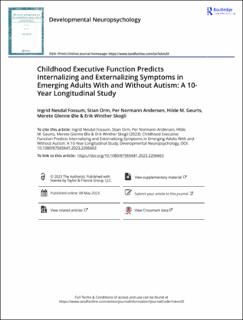| dc.contributor.author | Fossum, Ingrid Nesdal | |
| dc.contributor.author | Orm, Stian | |
| dc.contributor.author | Andersen, Per Normann | |
| dc.contributor.author | Geurts, Hilde M | |
| dc.contributor.author | Øie, Merete Glenne | |
| dc.contributor.author | Skogli, Erik Winther | |
| dc.date.accessioned | 2024-01-26T08:11:02Z | |
| dc.date.available | 2024-01-26T08:11:02Z | |
| dc.date.created | 2023-04-28T04:41:03Z | |
| dc.date.issued | 2023 | |
| dc.identifier.citation | Developmental Neuropsychology. 2023, 48 (3), 97-111. | en_US |
| dc.identifier.issn | 8756-5641 | |
| dc.identifier.uri | https://hdl.handle.net/11250/3114007 | |
| dc.description.abstract | Individuals with autism spectrum disorder (ASD) and typically developing individuals were assessed on three neuropsychological tests of executive function (EF) and on scales of autism symptoms and co-occurring internalizing and externalizing symptoms at baseline (T1; N = 88, Mage = 11.8 years, 73% males), 2-year (T2; 99% retention, Mage = 13.9 years), and 10-year follow-ups (T3; 75% retention, Mage = 21.4 years). An EF composite score from T1 significantly predicted internalizing symptoms at T2 (β = .228) and internalizing and externalizing symptoms at T3 (β = .431 and .478, respectively), when controlling for age and autism symptoms. OThe findings suggest that EF difficulties are a long-term risk factor for more co-occurring symptoms. | en_US |
| dc.description.abstract | Childhood executive function predicts internalizing and externalizing symptoms in emerging adults with and without autism: A 10-year longitudinal study | en_US |
| dc.description.sponsorship | This work was supported by grants from the Innlandet Hospital Trust (grant numbers: 150663, 150610, 150624, and 150648) and from the Norwegian Centre of Expertise for Neurodevelopmental Disorders and Hypersomnias, Department of Rare Disorders and Disabilities, Oslo University Hospital (grant number: 150616) | en_US |
| dc.language.iso | eng | en_US |
| dc.publisher | Taylor and Francis | en_US |
| dc.rights | Navngivelse 4.0 Internasjonal | * |
| dc.rights.uri | http://creativecommons.org/licenses/by/4.0/deed.no | * |
| dc.subject | Adolescent; | en_US |
| dc.subject | Adult; | en_US |
| dc.subject | Autism Spectrum Disorder* / diagnosis | en_US |
| dc.subject | Child | en_US |
| dc.subject | Autistic Disorder* | en_US |
| dc.subject | Executive Function | en_US |
| dc.subject | Female | en_US |
| dc.subject | Humans | en_US |
| dc.subject | Longitudinal Studies | en_US |
| dc.subject | Male | en_US |
| dc.subject | Young Adult | en_US |
| dc.title | Childhood executive function predicts internalizing and externalizing symptoms in emerging adults with and without autism: A 10-year longitudinal study | en_US |
| dc.title.alternative | Childhood executive function predicts internalizing and externalizing symptoms in emerging adults with and without autism: A 10-year longitudinal study | en_US |
| dc.type | Peer reviewed | en_US |
| dc.type | Journal article | en_US |
| dc.description.version | publishedVersion | en_US |
| dc.rights.holder | © 2023 The Author(s). Published with license by Taylor & Francis Group, LLC. This is an Open Access article distributed under the terms of the Creative Commons Attribution License (http://creativecommons.org/licenses/by/4.0/), which permits unrestricted use, distribution, and reproduction in any medium, provided the original work is properly cited. The terms on which this article has been published allow the posting of the Accepted Manuscript in a repository by the author(s) or with their consent. | en_US |
| dc.source.pagenumber | 97-111 | en_US |
| dc.source.volume | 48 | en_US |
| dc.source.journal | Developmental Neuropsychology | en_US |
| dc.source.issue | 3 | en_US |
| dc.identifier.doi | 10.1080/87565641.2023.2206663 | |
| dc.identifier.cristin | 2144012 | |
| cristin.ispublished | true | |
| cristin.fulltext | original | |
| cristin.fulltext | original | |
| cristin.qualitycode | 2 | |

